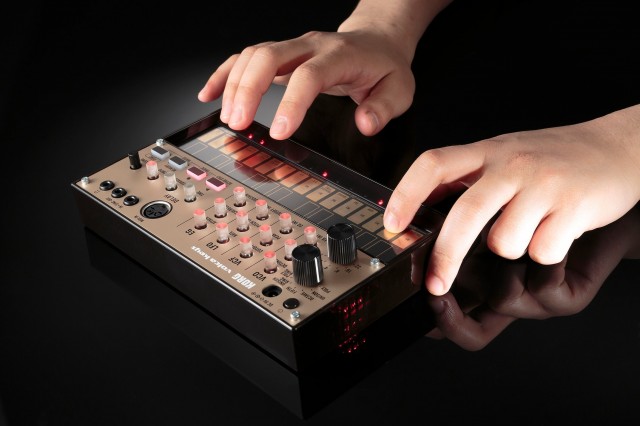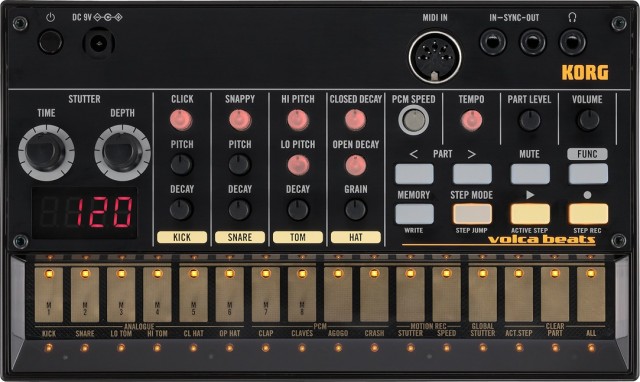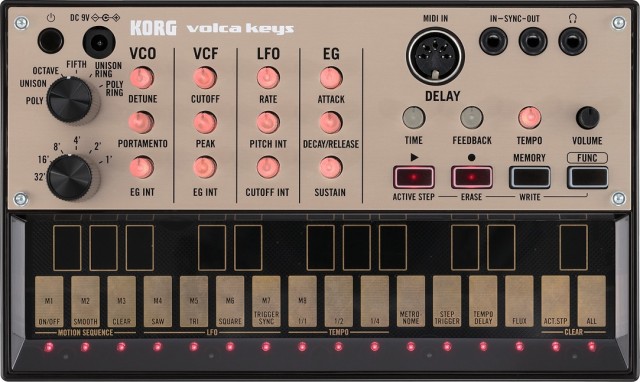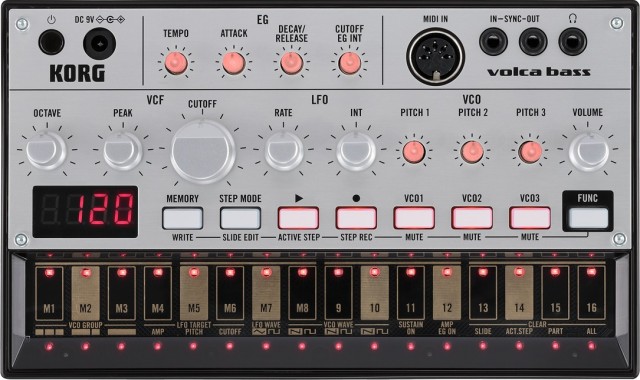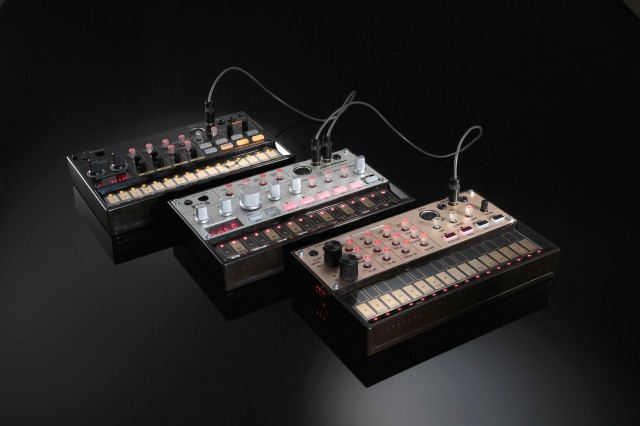
Beats, Bass, Keys – a drum machine, a bass synth, and a lead synth, analog and $150 each. Now with MIDI. All images courtesy KORG; click for biggie versions.
The rumors are true: Korg has not one, but three pint-sized, $150 analog groove boxes – two analog synths and a PCM/analog drum machine.
Korg established a bit of a formula with the Monotron and Monotribe: pack some vintage sound and quirky personality into a small box, make it all self-contained (with speaker, batteries, simple touch strips), and then make it affordable. The result is cute, little analog boxes that only Korg could make – and at a price only a big maker could pull off.
Volca keeps to that formula, with new synthesis and drum adding step sequencing features and MIDI that make these into bona fide groove boxes. That MIDI in port finally adds what previously required hacking your Monotron and Monotribe to achieve.
$149.99 for an analog groove box, and these things should sell like candy.
And while Roland seemed to ponder recently whether it should remake the TB-303, the Volca boxes look an awful lot like Roland’s classic bass synth, in form factor and mini keyboard. No matter – first indications are that these will sound very different. Like the MS-20 mini earlier this year, the synths also build on a remade classic Korg analog filter design. (The MS-20 mini, as a more slavish remake of an original and a full-fledged synth with patch bay and keyboard, seems otherwise a different animal, but the fact that it also reuses that filter is significant.)
Adding MIDI to me is a pretty significant improvement. So, while the Volcas do have tiny touch strips for when you don’t have a MIDI keyboard handy, you’re no longer forced to perform finger-twisting feats of musicianship – you can use a real keyboard or sequencer as with a “grown-up” synth. It seems that the Volca has lost none of the trademark, lovable oddness, though, in the process.
Video, so you can hear them:
The three Volca models:
Keys, a “lead” synth
Bass, a bass synth
Beats, a rhythm machine
And they create “the distinctive, massive sounds that can only come from a true analog synthesizer.” (Actually, okay, that’s not really what analog does, but it’d take a really long press release to explain what it means to be analog, so let’s just pretend it’s true and move on.)
Common features:
Loop sequencer (simple phrase-based storage for self-contained groove creation)
MIDI input (for control and sync, it seems)
Battery-powered
Built-in speakers
Minijack output
Minijack sync in/out (directly, for connecting Volcas)
Note that they no longer contain audio input, so the old monotron remains interesting as an effects box. Those three jacks are headphone, sync in, sync out.
Keys:
Three oscillators, tuned in unison up to three-part chords
Filter from the miniKORG700S, the 1974 Korg model (so before the 1978-vintage MS-10/20 filter in recent Korg outings)
16-step sequencer
Delay effects
Korg isn’t pitching this as a toy, either. They call the new synths “a new chapter in Korg’s long history of analog synthesizers,” and boast that the Lead generates sound beyond what you’d think in its small body.
Bass:
Similar to Keys, but focusing on bass sounds rather than leads, and with an eye, Korg says, to acid techno basslines
Step sequencer, “distilled” from Electribe (well, it works in a similar way)
Three oscillators with a voicing controls for different combinations
Beats:
All-analog sounds – not sampled – reproducing Kick, Snare, Hi Tom, Lo Tom, Closed Hi Hat, and Open Hi Hat
PCM samples of clap, crash, etc. (using PCM for that makes sense, and is in keeping with the retro style of these machines)
Variations for sounds, via controls Click, Pitch, Decay
16-part sequencer
Korg oversimplifies what it means to be analog here, it’s true. but it is fair to say that analog circuitry is a reasonable means to the kinds of sonic ends they’re describing. It’s even more true that having synths for the drum machine means that you can create variations stock samples don’t give you.
But I’m impressed that they’ve got a low price and economical use of controls that make these self-contained, wildly portable, and playable. In a way, the fact that you can run them with a pair of headphones and batteries makes it even more appealing that you can also use MIDI when you need it – you aren’t stuck with a closed box, but you can also play away from other gear.
July availability. US$149.99 each.
korg.com
I have lots of additional questions, so I’ll be getting up close with these here in Frankfurt. Keep an eye out.
I’ll also be looking to some of the boutique makers, not just Korg – yes, to readers saying check out MFB, you can bet I’ll do that. (It’ll just be easier after Messe – Korg returns to Japan, but some of these smaller makers go back to Berlin with me.)
Japanese product page: http://www.korg.co.jp/Product/Dance/volca/
US product page (taking a little bit to come online): http://korg.com/volca
